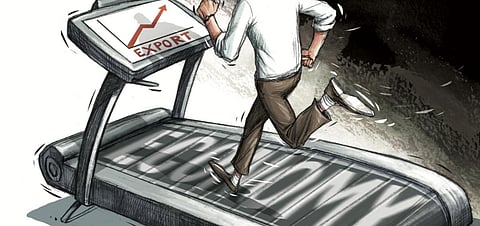

The recent release of India’s first quarter statistics warrants an article discussing the numbers, but more importantly, analysing the likely trajectory of the economy going forward. Such a discussion is important as many have been anxious with regards to their future economic conditions.
Even as growth statistics were being dissected, many were quick to point at the base effects, i.e. that the economy contracted in the first quarter of 2020 by 24.4%. No doubt, there is a base effect, but one must analyse the data while keeping in mind the large exogenous shocks that had an impact on our economy. These shocks are largely the first and second wave of the pandemic—and their lingering impact on sectors such as contact services. Thus, the contraction in the first quarter of the financial year was due to an exogenous shock of a pandemic that disrupted economic activity across the world due to lockdowns and other mobility restrictions.
That the economy was well on its path to recovery before the second wave hit us is also visible when one looks at the sequential quarterly GDP numbers. In fact, when one looks at the first quarter results, we must keep in mind that this was despite the second wave of the pandemic and therefore, while there is a base effect, there was also the simultaneous impact of another wave of surge in infections.
There are two things that are certain given the latest data print: first is that the second wave did not have much impact on our economy; instead, it perhaps just delayed or rather prolonged our growth recovery process. Second, the economy is well on track to achieve a modest growth compared to the 2019 levels in India. Sequential growth statistics are of instructive use as one can clearly note visible trends that suggest an ongoing recovery cycle that appears to be robust even though it may be prolonged.
This recovery in part has been achieved through a cleverly designed Covid-19 stimulus package that provided income support to the poor and vulnerable—whether in the form of cash transfers or free food grains. For the businesses, support was provided in the form of credit guarantees. This was further supported by various incentives to manufacturing firms along with a comprehensive agenda of economic reforms.
India’s GDP in 2021 will therefore be slightly more than that in 2019, but this means that the pandemic has in fact imposed an opportunity cost in the form of foregone growth on the economy. Of course, it is still too soon to evaluate if there will be any long-term impact, whether on human capital or productivity levels due to the pandemic, but so far it appears that the approach towards reforms were focused on preventing them in some ways.
Even as many caution about the looming prospects of a third wave, the muted economic impact of the second wave reveals the decreasing impact of the progression of the pandemic on the economy. Moreover, with India’s vaccination efforts picking pace, one is hopeful that there may not be a third wave and even if there is one, it may be muted.
The key takeaways for me from the latest print also included the fact that the government’s spending has been modest during the first quarter, which means the bulk of the recovery was aided by consumption expenditures and investments in the economy. The 8.7% increase in our exports compared to 2019 are also positive and it reaffirms the view presented repeatedly about the stimulus given in advanced economies having a positive impact on India’s growth recovery process.
It is encouraging to note that the recovery has been largely aided by the private sector rather than government expenditures as it should reflect a healthier fiscal position for the exchequer over time. However, it will be a good idea to continue with the expenditures provisioned in the Budget over the second half of the financial year and continue with higher-than-usual expenditures in the form of capital outlays for the coming years. This will be instrumental in recovering the opportunity costs in the form of lower growth in 2019, 2020 and 2021 while also helping create fresh infrastructure as envisaged in the National Infrastructure Pipeline.
The first quarter growth statistics may still be 9% below Q1 2019-20; however, there is a real possibility that 2021 will see a very modest growth over the 2019 economic levels. Therefore, one can safely argue that the worst for the economy is largely over. As far as future growth trajectory is concerned, there are far too many forecasters in the ring, but my money is on sustaining a 7-7.5% growth rate over this decade while registering an 8% or so growth rate over the foreseeable future.
Karan Bhasin, New York-based policy researcher (karanbhasin95@gmail.com)